Experimental and Numerical Investigation on Finned Vortex Reducer in a Rotating Cavity with a Radial Inflow
Abstract
1. Introduction
2. Experimental and Simulation Methods
2.1. Test Rig
2.2. Test Section
2.3. Numerical Model
2.4. Nondimensional Parameters
3. Results and Discussion
3.1. Flow Structure
Region I
Region II
Region III
3.2. Pressure Loss
4. Conclusions
- The flow structures in different regions of the radial inflow with the presence of the finned vortex reducer exhibit characteristic patterns. The cavity structure is divided into different regions, in which the flow in region I and region III conforms to the free vortex flow model. The swirl ratio increases radially, with a decrease at the junction and turning points due to shock dissipation. Inside the fin passages, the swirl ratio is constrained to be near one, representing a forced flow structure.
- The fins restrict the flow to a radially inward motion, acting as a rectifier. This inhibits the growth of the swirl ratio within the cavity and reduces the radial Coriolis force acting in the outward direction, reducing the pressure loss of the finned vortex reducer.
- The pressure loss of the cavity is influenced by a combination of aerodynamic parameters such as the rotational Reynolds number and flow coefficient, as well as the radial positions of the inlet and outlet of the fins. The minimum pressure loss of the cavity is achieved when the inlet position corresponds to a swirl ratio of one. Further research is needed to understand the impact of the outlet position of the fins on the overall pressure loss of the cavity.
- The pressure loss between different sections of the finned vortex reducer increases with higher rotational Reynolds numbers and dimensionless mass flow rates. Within the range of rotational Reynolds numbers considered in this study, the pressure loss models based on flow characteristics in region II, obtained through integral calculations, effectively reflect the pressure variation.
Author Contributions
Funding
Data Availability Statement
Acknowledgments
Conflicts of Interest
References
- Brillert, D.; Reichert, A.W.; Simon, H. Calculation of Flow Losses in Rotating Passages of Gas Turbine Cooling Systems. In Proceedings of the ASME 1999 International Gas Turbine and Aeroengine Congress and Exhibition, Indianapolis, IN, USA, 7–10 June 1999. [Google Scholar]
- Chew, J.W.; Snell, R.J. Prediction of the Pressure Distribution for Radial Inflow Between Co-Rotating Discs. In Proceedings of the ASME, Gas Turbine and Aeroengine Congress and Exposition, Amsterdam, The Netherlands, 6–9 June 1988. [Google Scholar]
- Alberga, D.G.; Stephens, G.E.; Johnson, B.V. Comparison of Predicted and Measured Velocities in a Compressor Disk Drum Model. In Turbo Expo: Power for Land, Sea, and Air; American Society of Mechanical Engineers: Anaheim, CA, USA, 1987. [Google Scholar]
- Owen, J.M.; Wilson, M. Some current research in rotating-disc systems. Ann. N. Y. Acad. Sci. 2001, 934, 206–221. [Google Scholar] [CrossRef]
- Hide, R. On source-sink flows in a rotating fluid. J. Fluid Mech. 1967, 32, 737–764. [Google Scholar] [CrossRef]
- Owen, J.M.; Pincombe, J.R.; Rogers, R.H. Source–sink flow inside a rotating cylindrical cavity. J. Fluid Mech. 1985, 155, 233–265. [Google Scholar] [CrossRef]
- Firouzian, M.; Owen, J.M.; Pincombe, J.R.; Rogers, R.H. Flow and heat transfer in a rotating cavity with a radial inflow of fluid Part 1: The flow structure. Int. J. Heat Fluid Flow 1985, 6, 228–234. [Google Scholar] [CrossRef]
- Firouzian, M.; Owen, J.M.; Pincombe, J.R.; Rogers, R.H. Flow and heat transfer in a rotating cylindrical cavity with a radial inflow of fluid: Part 2: Velocity, pressure and heat transfer measurements. Int. J. Heat Fluid Flow 1986, 7, 21–27. [Google Scholar] [CrossRef]
- Farthing, P.R.; Chew, J.W.; Owen, J.M. The Use of De-Swirl Nozzles to Reduce the Pressure Drop in a Rotating Cavity with a Radial Inflow. J. Turbomach. 1991, 113, 106–114. [Google Scholar] [CrossRef]
- Pfitzner, M.; Waschka, W. Development of An Aeroengine Secondary Air System Employing Vortex Reducers. In Proceedings of the International Congress of Aeronautical Sciences, ICAS, Harrogate, UK, 27 August–1 September 2000. [Google Scholar]
- Chew, J.W.; Farthing, P.R.; Owen, J.M.; Stratford, B. The Use of Fins to Reduce the Pressure Drop in a Rotating Cavity with a Radial Inflow. J. Turbomach. 1989, 111, 349–356. [Google Scholar] [CrossRef]
- Luo, X.; Feng, A.; Quan, Y.; Zhou, Z.; Liao, N. Experimental analysis of varied vortex reducers in reducing the pressure drop in a rotating cavity with radial inflow. Exp. Therm. Fluid Sci. 2016, 77, 159–166. [Google Scholar] [CrossRef]
- Günther, A.; Uffrecht, W.; Kaiser, E.; Odenbach, S.; Heller, L. Experimental Analysis of Varied Vortex Reducer Configurations for the Internal Air System of Jet Engine Gas Turbines. In Proceedings of the ASME Turbo Expo 2008: Power for Land, Sea, and Air, Berlin, Germany, 9–13 June 2008. [Google Scholar]
- Farthing, P.R.; Owen, J.M. De-swirled radial inflow in a rotating cavity. Int. J. Heat Fluid Flow 1991, 12, 63–70. [Google Scholar] [CrossRef]
- May, D.; Chew, J.W.; Scanlon, T.J. Prediction of Deswirled Radial Inflow in Rotating Cavities With Hysteresis. J. Turbomach. 2013, 135, 41025. [Google Scholar] [CrossRef]
- Negulescu, D.; Pfitzner, M. Secondary Air Systems in Aeroengines Employing Vortex Reducers. In Proceedings of the ASME Turbo Expo: Power for Land, Sea, & Air, New Orleans, LO, USA, 4–7 June 2001; p. V003T001A072. [Google Scholar]
- Sibilli, T.; Cho, G.H. Numerical Analysis of Industrial Gas Turbine Secondary Air Systems Employing Vortex Reducers. In Proceedings of the ASME Turbo Expo 2018: Turbomachinery Technical Conference and Exposition, Oslo, Norway, 11–15 June 2018. [Google Scholar]
- Bai, Y.; Luo, X.; He, J. Influence of turbulence parameters on flow characteristics of cavity with tubed vortex reducer. J. Aerosp. Power 2022, 37, 1295–1305. [Google Scholar]
- Du, X.Q.; Zhu, H.R.; Zhang, Z.W. Numerical Study on Varied Vortex Reducer Configurations for the Flow Path Optimization in Compressor Cavities. In Proceedings of the ASME Turbo Expo: Turbine Technical Conference & Exposition, Vancouver, BC, Canada, 6–10 June 2011. [Google Scholar]
- Bai, Y.; Luo, X.; He, J. Numerical simulation of total pressure loss on vortex reducer with bafflers. J. Aerosp. Power 2019, 34, 2120–2130. [Google Scholar]
- Hou, X.-T.; Wang, S.-F.; Zhang, K. Numerical Investigation on Effects of Installation Height of Fins on Drag Reduction Performance of Co-Rotating Cavity. J. Propuls. Technol. 2020, 41, 1457–1463. [Google Scholar]
- Roache, P.J. Quantification of Uncertainty in Computational Fluid Dynamics; Annual Reviews Inc.: Palo Alto, CA, USA, 1997; Volume 29, pp. 123–160. [Google Scholar]

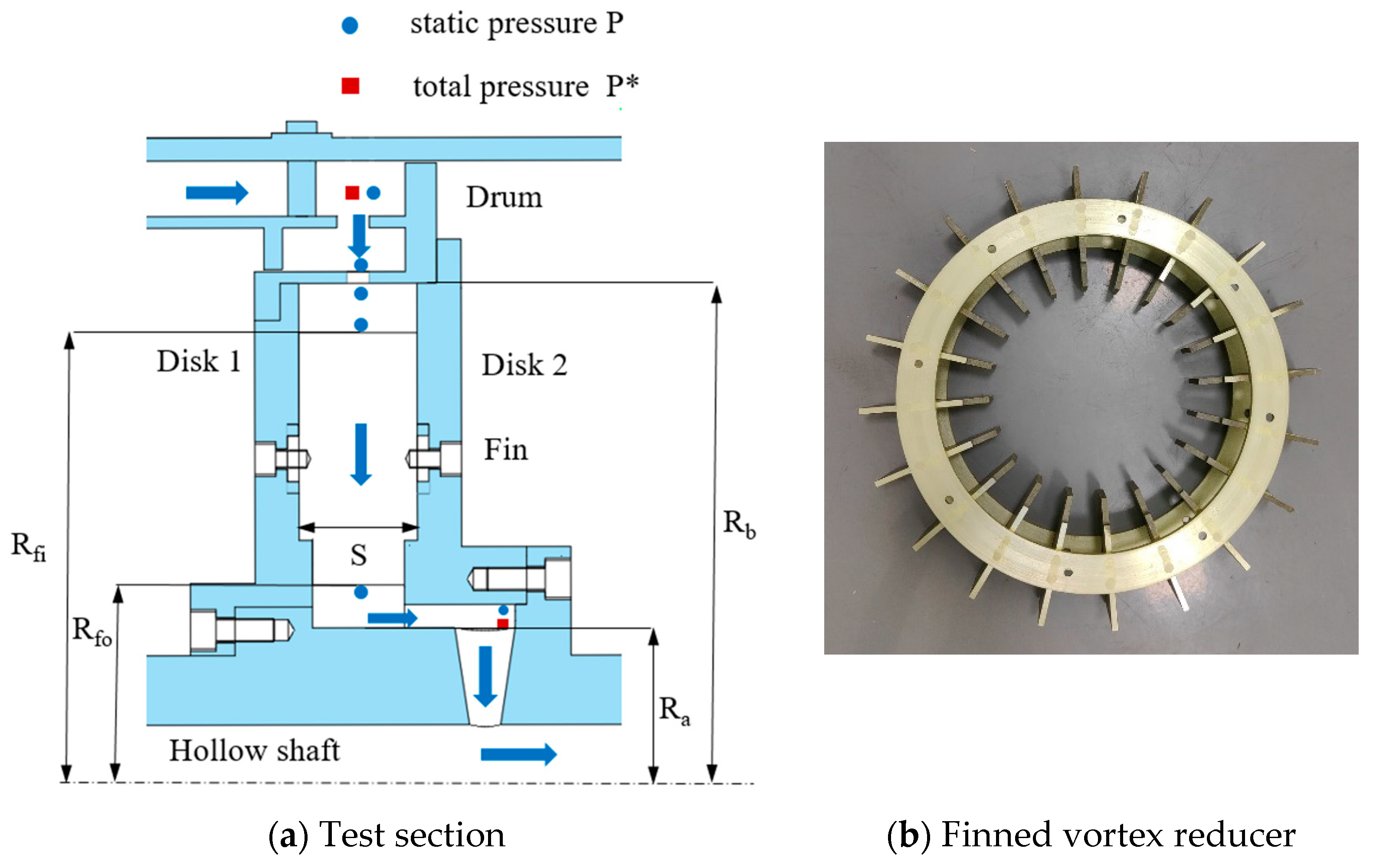
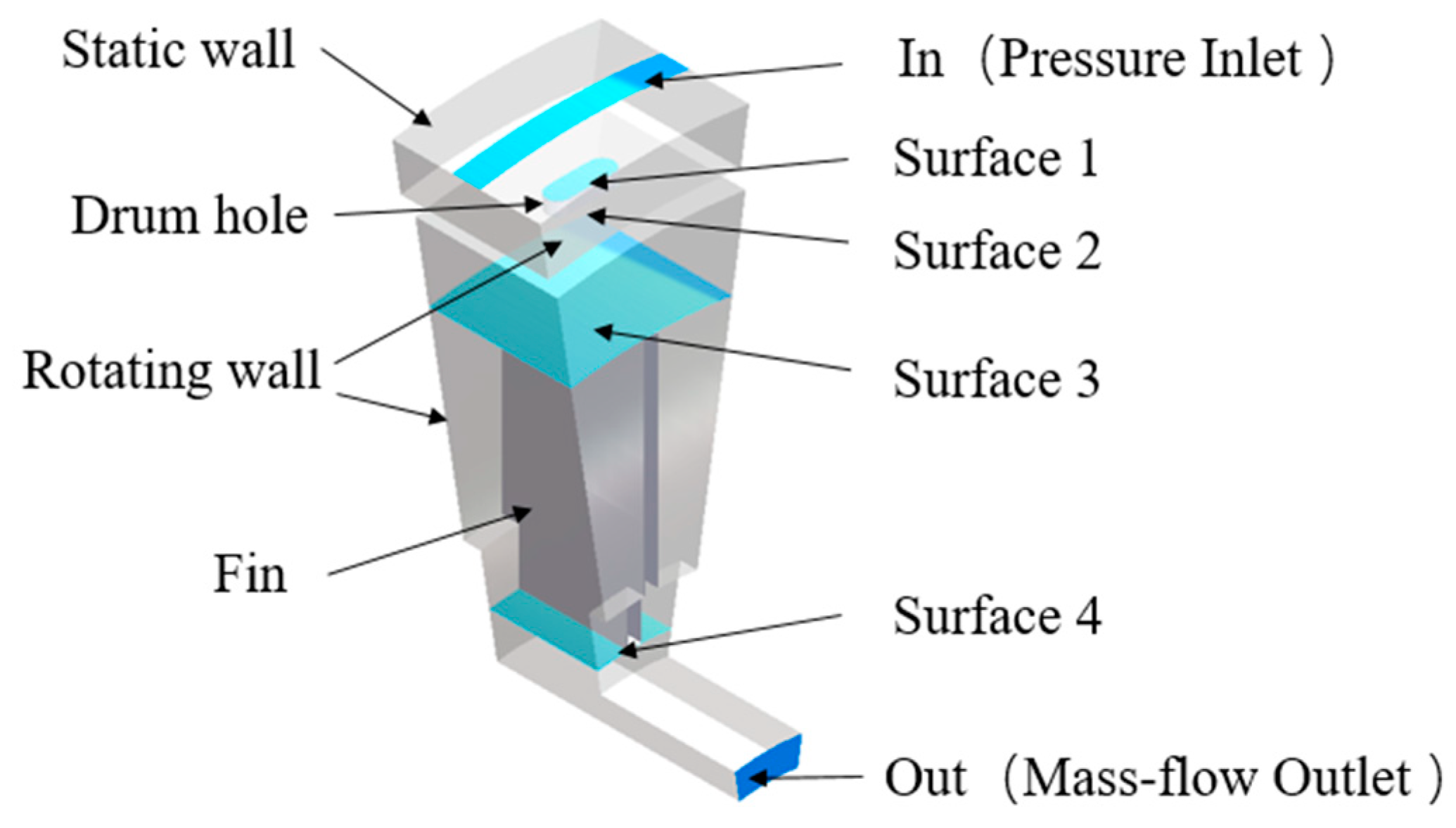
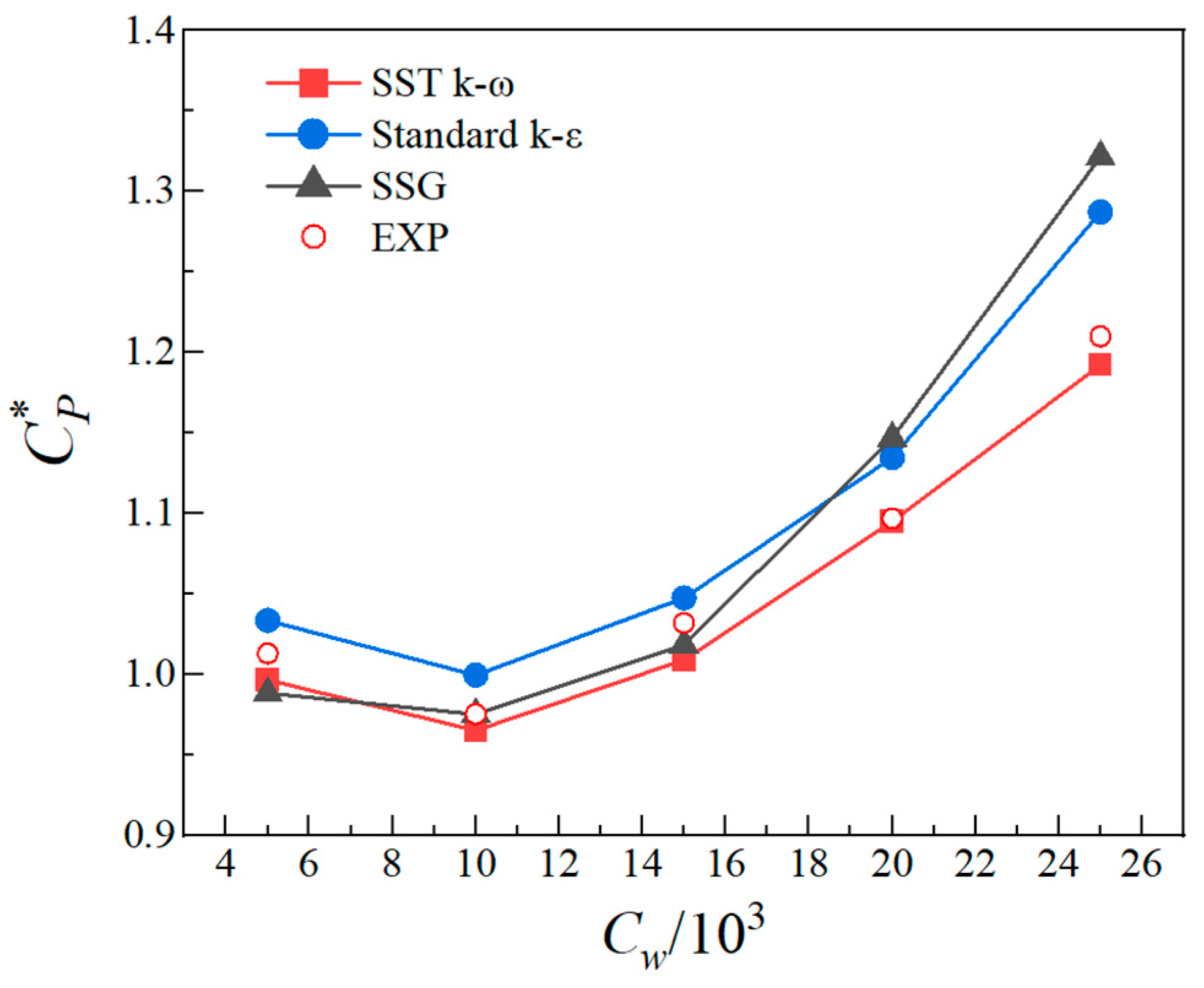




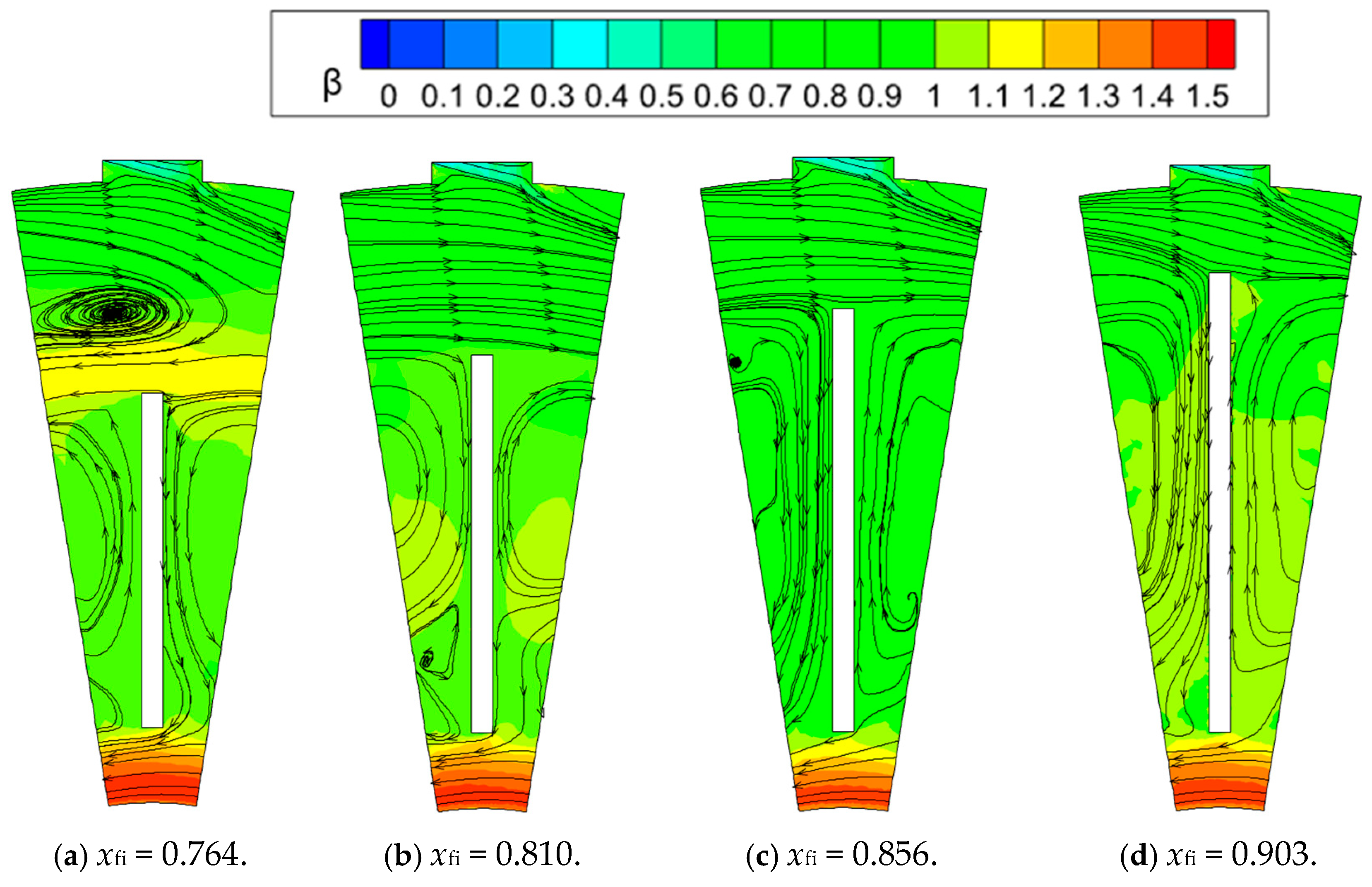
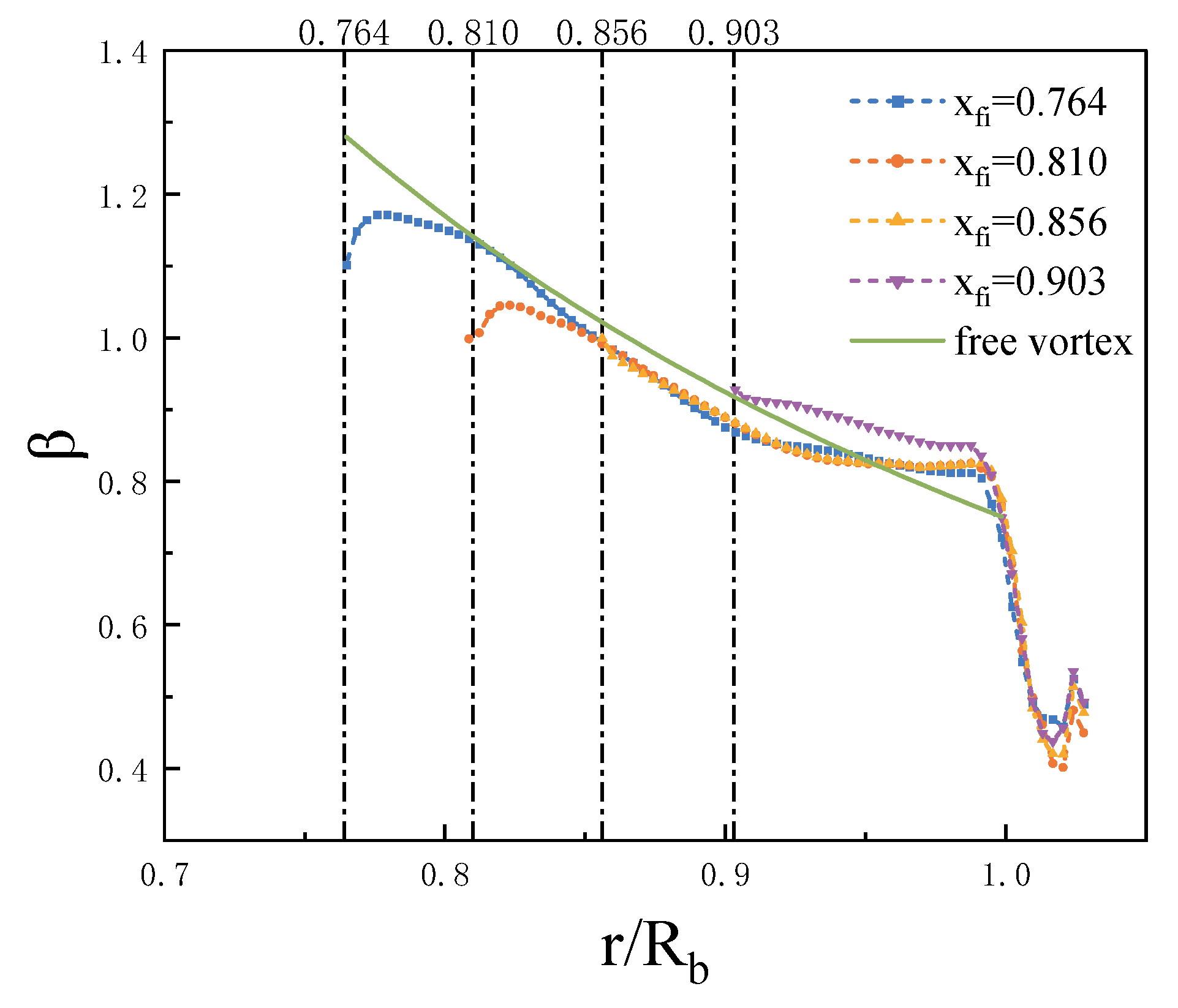
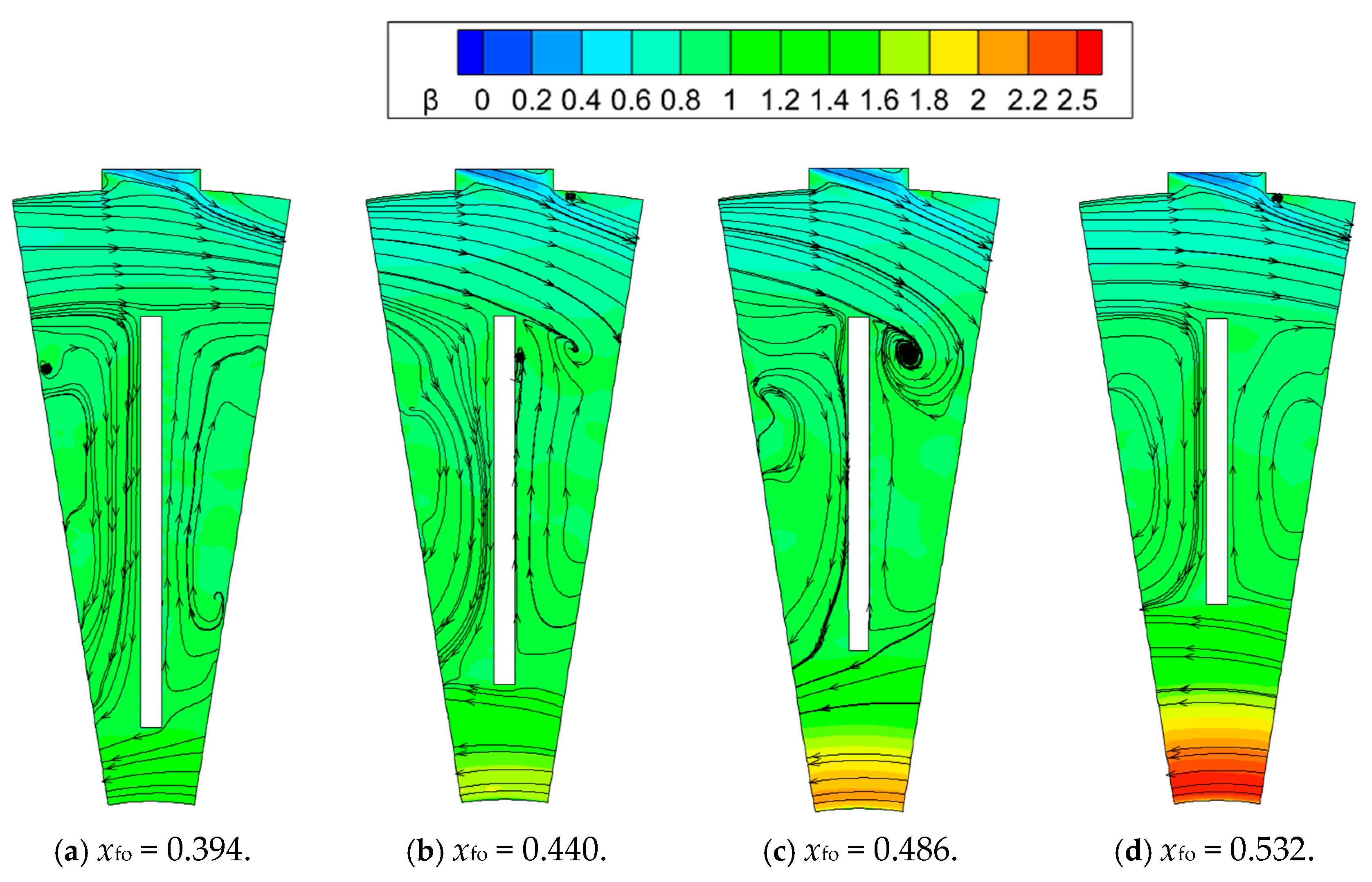



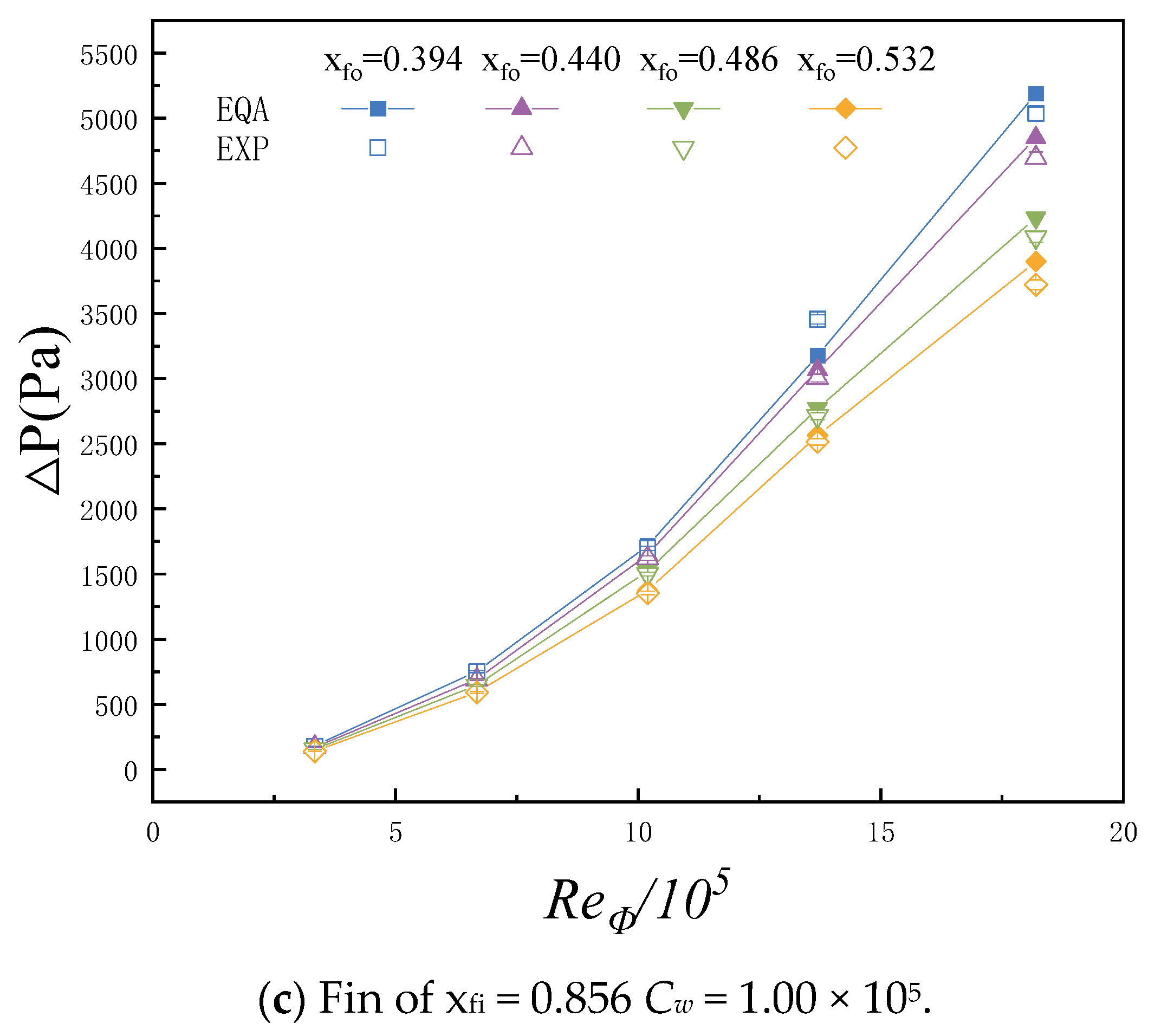

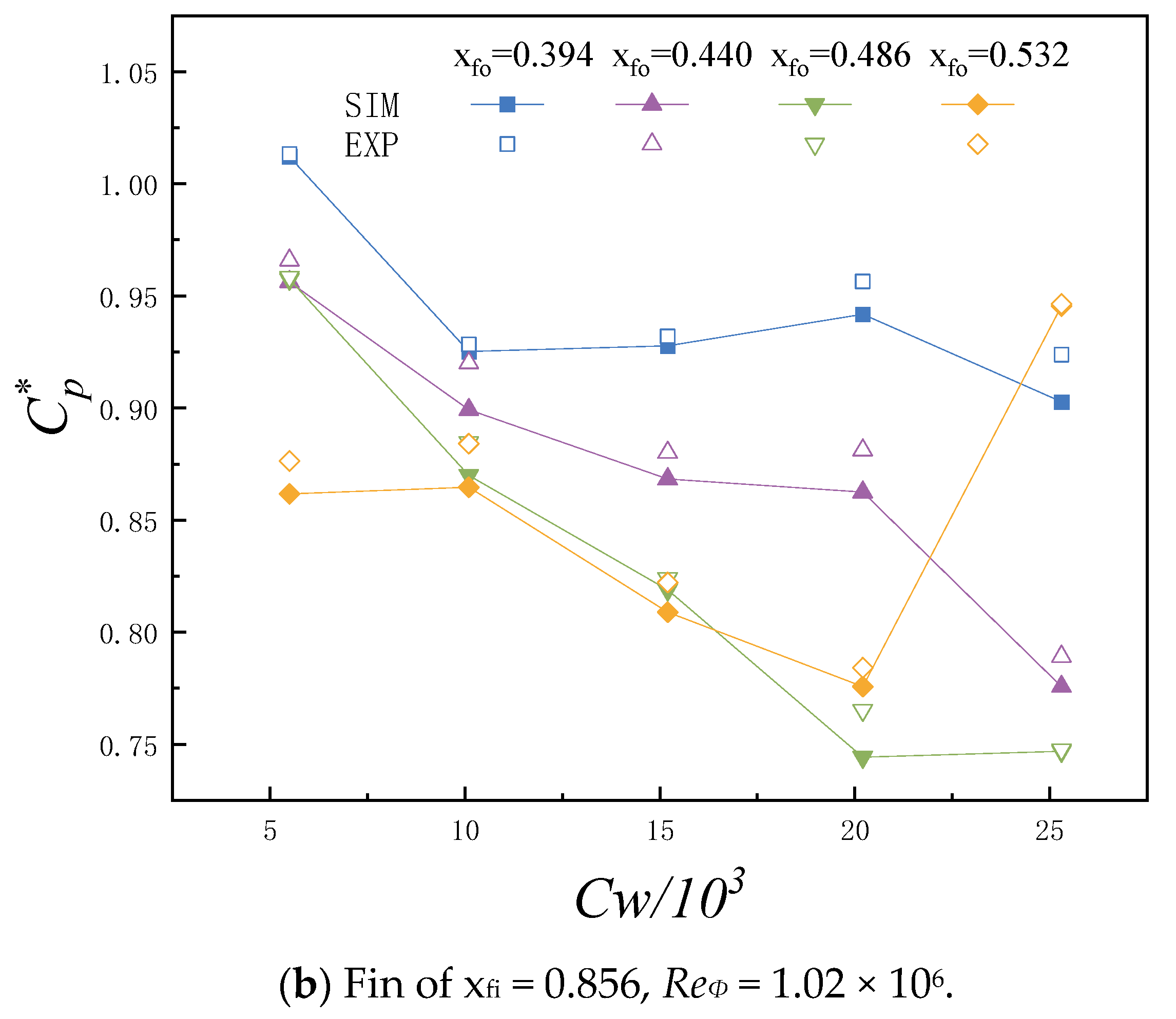
| Rb | 216 (mm) |
| Xa | 0.310 |
| Xfi | 0.764, 0.810, 0.856, 0.903 |
| Xfo | 0.394, 0.440, 0.486, 0.532 |
| G | 0.236 |
| Pressure | Rotate Speed (rpm) | ReΦ | Mass Flow Rate (kg·s−1) | Cw |
|---|---|---|---|---|
| Consistent with experimental data | 1000 | 3.34 × 105 | 0.02 | 5.00 × 104 |
| 2000 | 6.68 × 105 | 0.04 | 1.00 × 105 | |
| 3000 | 1.02 × 106 | 0.06 | 1.51 × 105 | |
| 4000 | 1.37 × 106 | 0.08 | 2.01 × 105 | |
| 5000 | 1.82 × 106 | 0.1 | 2.52 × 105 |
| Grid Number (million) | Fs | p | △P (Pa) | GCI |
|---|---|---|---|---|
| 0.8 | 3 | 6 | 8762 | |
| 1.07 | 3 | 6 | 8451 | 3.5% |
| 1.35 | 3 | 6 | 8489 | 2.6% |
| 1.80 | 3 | 6 | 8412 | 1.8% |
| 2.30 | 3 | 6 | 8438 | 1.1% |
Disclaimer/Publisher’s Note: The statements, opinions and data contained in all publications are solely those of the individual author(s) and contributor(s) and not of MDPI and/or the editor(s). MDPI and/or the editor(s) disclaim responsibility for any injury to people or property resulting from any ideas, methods, instructions or products referred to in the content. |
© 2023 by the authors. Licensee MDPI, Basel, Switzerland. This article is an open access article distributed under the terms and conditions of the Creative Commons Attribution (CC BY) license (https://creativecommons.org/licenses/by/4.0/).
Share and Cite
He, J.; Luo, X.; Bai, Y.; Song, A.; Yang, T. Experimental and Numerical Investigation on Finned Vortex Reducer in a Rotating Cavity with a Radial Inflow. Aerospace 2023, 10, 655. https://doi.org/10.3390/aerospace10070655
He J, Luo X, Bai Y, Song A, Yang T. Experimental and Numerical Investigation on Finned Vortex Reducer in a Rotating Cavity with a Radial Inflow. Aerospace. 2023; 10(7):655. https://doi.org/10.3390/aerospace10070655
Chicago/Turabian StyleHe, Jian, Xiang Luo, Yang Bai, An Song, and Tao Yang. 2023. "Experimental and Numerical Investigation on Finned Vortex Reducer in a Rotating Cavity with a Radial Inflow" Aerospace 10, no. 7: 655. https://doi.org/10.3390/aerospace10070655
APA StyleHe, J., Luo, X., Bai, Y., Song, A., & Yang, T. (2023). Experimental and Numerical Investigation on Finned Vortex Reducer in a Rotating Cavity with a Radial Inflow. Aerospace, 10(7), 655. https://doi.org/10.3390/aerospace10070655





